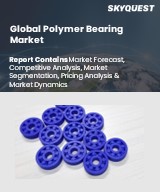
Report ID: SQMIG15F2177

Report ID:
SQMIG15F2177 |
Region:
Global |
Published Date: March, 2024
Pages:
157
|
Tables:
67 |
Figures:
68
Drivers
Increasing demand for polymer bearings in industrial sectors such as medical & pharmaceutical, automotive, textiles, food processing, among others is expected to be a major factor driving the growth of the polymer bearing market. After automobiles, the automotive industry is the second largest consumer of polymers. According to the Gulf Petrochemicals and Chemicals Association, about 1/3 of the 30,000 auto parts are made of plastic. Automobiles are made of about 39 different types of plastics and polymers. But more than 70% of plastics used in automobiles are composed of four polymers, polypropylene, polyurethane, polyamide and polyvinyl chloride (PVC).
Expanding application of polymer bearings in automotive, medical & pharmaceutical, textiles, food processing, pharmaceutical, office supplies, semiconductor industries is contributing to the expansion of polymer bearing market across the globe. Polymer bearings are preferred over metal surfaces. Polymers have many advantages compared to other traditional bearing materials. Polymer bearings are corrosion resistant and chemical resistant. Because these bearings are self-lubricating, heat is not transferred to other machinery assembly areas, eliminating the risk of failure due to lack of maintenance so these products are driving the expansion of the global polymer bearing market.
Restraints
But stringent government regulations on its use in the food packaging and processing industries have restricted further expansion of the polymer bearing industry in addition to changes in raw material prices that has restricted the profitability of the industry, thereby affecting the price trend of polymer bearing. Furthermore, phenolic bearings with low thermal conductivity due to friction requiring continuous supply of water or lubricating oil to reduce temperature may also hamper market growth.
This industry faces challenges due to variable inputs and high maintenance costs, which hamper its growth and profitability. Changes in raw material costs can have a significant impact on this industry. As prices increase, bearings are usually made of metal, ceramic, or polymers. Fluctuations in raw material costs have a direct impact on production carrying costs, making it difficult for manufacturers to maintain price stability and profitability in 2010. Producers may also find it difficult to obtain consistent and high-quality raw materials at competitive prices, disrupting the supply chain.
Our industry expert will work with you to provide you with customized data in a short amount of time.
REQUEST FREE CUSTOMIZATIONWant to customize this report? This report can be personalized according to your needs. Our analysts and industry experts will work directly with you to understand your requirements and provide you with customized data in a short amount of time. We offer $1000 worth of FREE customization at the time of purchase.

Report ID: SQMIG15F2177